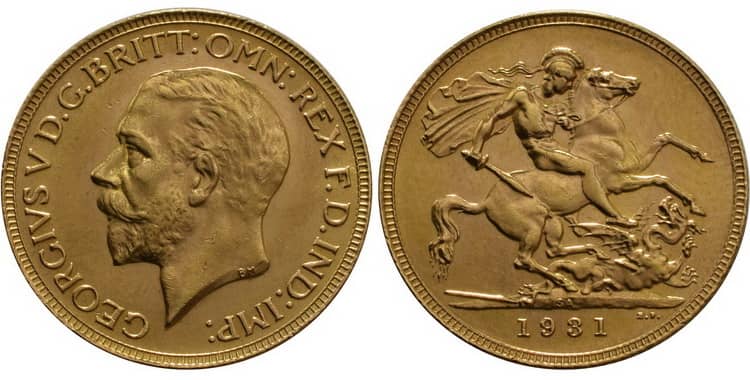
Sovereign of South Africa (1925-1932) is the legendary gold coin, common in the UK and the former British colonies (Australia, Canada, South Africa, India). In difficult times, its own production helped the African state to develop money circulation within the country and abroad. Over the years, these old specimens began to be in demand among collectors and investors no less than Krugerrand gold due to the unsurpassed artistic value and high quality of the precious metal.
History
The first sovereigns appeared on the territory of Great Britain. Gold coins began to be minted in 1489 under Henry VII. More modern samples, which became the basis for coins in the British colonies, was released in 1817 under George III. According to the tradition, on the reverse side there was the image of St. George the Victorious with a spear in his hand, on the obverse – a portrait of the ruling monarch. George V ruled from 1925 to 1936, so the profile of this king is found on the golden sovereigns of South Africa in 1925-1932.
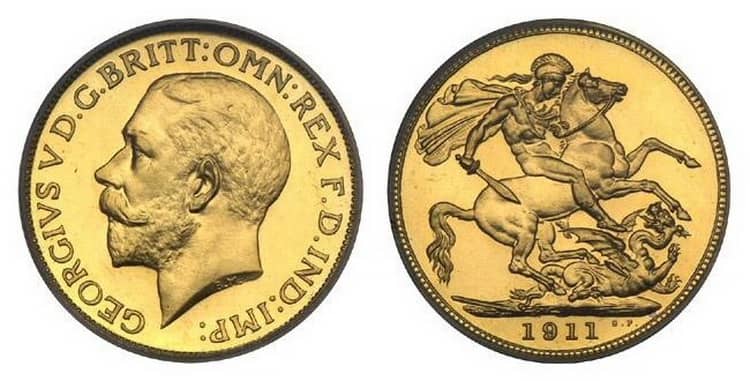
In 1892, they began to produce their own currency from gold on the territory of South Africa, but production was stopped in 1919 due to the hostilities of the British occupation. As a result, South Africa was declared a colony of Great Britain, the local money was replaced by an English standard. New gold coins were recognized everywhere – they were used as a currency in different countries. South African coins became popular outside the continent. The soldiers took them with them to military events to pay in foreign territory.
Did you know? Despite the fact that the territory of South Africa is rich in deposits of precious metals and its own Mint functioned in the country, its own currency has not been minted here for a long time. Initially (in the mid-1600s) South Africa belonged to the Dutch, and for trade they used reales, guilders and ducats – the main money of the Netherlands. As a result, the South African country became a British colony (in 1806), and gained its independence in 1931. Only after that, in 1961 in South Africa began to produce the national currency – rand.
The British minted the South African sovereigns of 1925-1932 on their own production, built in Pretoria. Prior to this, the first South African Mint functioning from 1892 to 1900, was closed after the end of the Boer War. Instead, the British established their Mint, making it a branch of the Royal Mint. The production was so powerful and advanced that in the early years South African gold and silver coins were released in record quantities – about 60,000,000 copies.
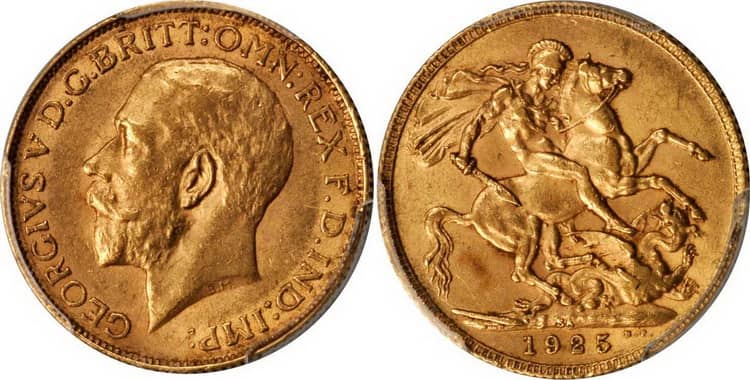
Sovereigns of gold minted in the production of different countries:
- London (no sign of MD);
- Melbourne (sign M);
- Perth (sign P);
- Sydney (sign S);
- Pretoria (SA);
- Bombay (sign B).
This feature is one of the reasons why collectors prefer to collect British sovereigns minted in different countries. Some samples of gold British coins are hard to find. The South African copy can be distinguished by a small label – the inscription SA, located above the year of mintage. The product is so small that it can only be viewed with a loupe.
Did you know? The British government planned to introduce its own currency on a sterling basis in all existing colonies. But the supply of coins to pay for garrison troops in South Africa was insufficient, so the British used other coins, such as the currencies of Spain, the United States and France, as well as India. Also, legal tender were declared gold coins of Sydney.
By 1923, the production of South African sovereigns was established. The first two years the circulation was insignificant, but since 1925, the circulation of gold coins reached several million. In 1932 there was a global financial crisis. The gold standard was abandoned, and the coinage of sovereigns for circulation was stopped. All coins for Great Britain were minted only in London.
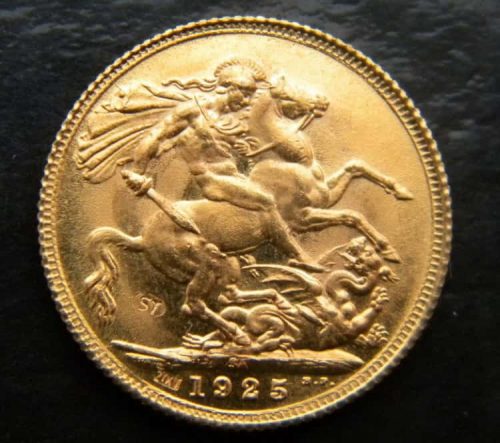
In 1941, production in Pretoria was transferred under the control of the South African government and made an independent enterprise. Currently, there are orders for the minting of money from precious metals for South Africa. It was here, with the support of the Rand refining plant, that the first Krugerrand investment coin (1967) was produced, and then world-famous numismatic and collection copies, including the South African gold coins of the Nature series.
Design
The South African sovereigns, like any others, were minted in the British style. The portrait designer of George V was Edgar Bertram MacKennal – an Australian sculptor. He owns the world-famous works – the statue of Queen Victoria for Australia, England, Lahore, the winners’ medals for the 1908 Olympic Games. The first plaster bust of George V was designed according to the photograph of the king. When the sketch was ready, the artist personally met with the monarch and finished the work. Next, the sculptural model was adapted to the size of the coin.
Did you know? The history of minting gold coins in South Africa began in 1886, when extensive reserves of precious metal were found in the Witwatersrand area. In just three years, South Africa has become the world leader in the production of gold products, and trade and commerce in the country began to develop rapidly. At the same time, South African President Paul Kruger proposed the creation of a national Mint. On July 6, 1892, the Mint was built in Pretoria. The latest production allowed to solve several problems that existed in South Africa at that time.
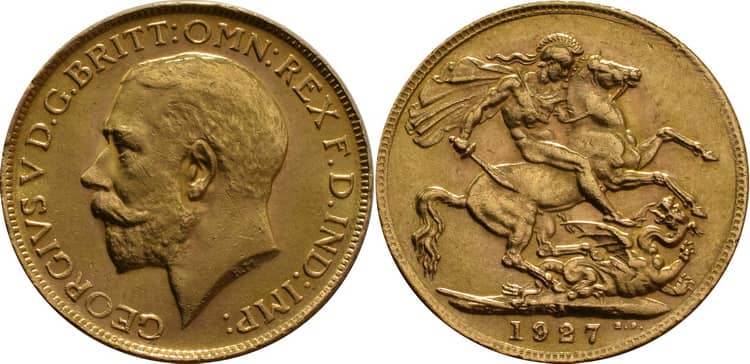
Characteristics of South African sovereigns of 1925-1932
Metal: gold.
Sample: 0.917.
Weight: 7.99 grams.
Par: 1 sovereign
Diameter: 22 mm.
Quality: Unc.
Did you know? The content of gold in the sovereignty is established by law, issued in 1816. It looks like this: “The weight of the gold sovereigns is 0.2354 troy ounces (7.99 grams) of the precious metal, the composition is 22 carats (0.9167 pure gold), which is equivalent to 113 facets.”
Obverse: Portrait of the king facing left. Under him, Bertram Makkenal’s initials “B.M.” are minted in small letters. On the edge of the sovereign there is the inscription “GEORGIVS V D.G.BRITT: OMN: REX F.D.IND: IMP:” (By the grace of God, the king of all Britain, George V, defender of the faith, emperor of India).
Reverse: The reverse side of the coin is decorated with the legendary work of the young but talented Italian engraver Benedetto Pestrucci. On the reverse is the figure of St. George on his brave horse, killing a mythical dragon. Below is the year of embossing and the initials of the artist “B.P”.
Circulation
In 1923 a trial series of South African sovereigns was published. The first edition was only 423 copies. In 1924, the production of coins began in earnest, and after nine years of minting gold coins for the Royal Mint, the Pretoria plant produced more than 83.4 million sovereigns in South Africa.
The annual edition of the sovereigns of South Africa was:
- 1927 – 16,379,504 pieces;
- 1929 – 12,024,000 pieces;
- 1930 – 10,028,000 pieces;
- 1931 – 8,512,000 pieces;
- 1932 – 1,067,000 pieces.
Cost of coins
Sovereigns of South Africa minted in large quantities, so the coins made of gold are practically of no numismatic value (only copies issued in the early years). The cost of a well-preserved specimen is $ USD 250-300. Coins in quality VF and less will cost $ USD 150.
Comments
No commens yet.